However, the severe issues that have been causing usability problems in Windows Server remain. Check our full coverage on Microsoft’s decision to reinstate the updates without a fix and what the company says about the issues. [14.01.22 – 17:26 CET] Microsoft is no longer rolling out January 2022 Patch Tuesday updates to Windows Server. The company has taken the decision to pull the cumulative updates following critical bugs the patches were causing. Users were reporting bugs causing domain controllers to reboot, ReFS colume to go missing, and functionality issues in Hyper-V. During this month’s January 2022 Patch Tuesday, Windows Server go the following updates: KB5009624 for Windows Server 2012 R2, KB5009557 for Windows Server 2019, and KB5009555 for Windows Server 2022. All of these releases have now been removed. Microsoft reacted to reports from system admins who found major issues causing critical failures. The company decided the best course of action was to stop those updates from reaching other customers. However, that does mean users are left with the security vulnerabilities the updates were meant to patch. Unfortunately, this is an all-too-common occurrence in Microsoft’s update cycle. Multiple times over the years Patch Tuesday updates have caused wider issues in Microsoft services.
Patch Tuesday
Microsoft handled 97 bugs and flaws in its services during this month’s Patch Tuesday updates, which went live earlier this week. Nine of them the company rates as critical, while six of them are zero-days. In this package are patches for Windows, Microsoft Edge, Windows Components, Microsoft Office, .NET Framework, Exchange Server, Hyper-V, Microsoft Dynamics, Windows Defender, Open-Source Software, Windows Defender, and more. Microsoft says none of the six zero-days that it is patching this month are being actively exploited. The company has not said when it will restore the KB updates for Windows Server. Tip of the day: Do you often experience PC freezes or crashs with Blue Screens of Death (BSOD)? Then you should use Windows Memory Diagnostic to test your computers RAM for any problems that might be caused from damaged memory modules. It is a tool built which can be launched at startup to run various memory checks.




